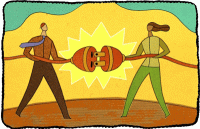Connecting Educators Benefits Students
(Updated 10/2013)
As part of Connected Educator Month, I wanted to share something about the value of being a connected educator -- the value for your students. It's great that we, as educators, are connected to one another, but what does that mean for the students?
Long-Distance Collaboration
Taking the connections and turning them into lessons that can impact students is really one of the keys to being a connected educator. Since I reached out and connected with educators from all over the world, I've seen a wonderful change in my teaching that has made a positive impact on my students. Here is just one example of connections affecting students in my classroom.
When I first jumped on Twitter and launched my blog in January 2010, I had no idea what I was doing or where I was going. The next thing I knew, I was in Denver for ISTE. At a tweetup, I met Shannon Miller (@ShannonMMiller) and we talked shop. I said it would be fun if we could work together on a project. Shannon wasted no time in connecting me with an English teacher at her school, and we got to work. We created shared lit circles and did projects that connected our two schools together. By connecting, I was able to take my students from suburban Detroit to a rural school in Van Meter, Iowa. My students even produced a lip dub to introduce our school to theirs. To top it off, our students produced a full version of Romeo and Juliet. You can see how things went with the project on my blog. At one point, in a quest to contact Taylor Swift, I was trending in Canada! My students Skyped with Iowa and had a joint premiere on a Saturday to watch their video. It was an amazing school year that my students will never forget.
These events were possible only because I decided to reach out and connect with educators in the world around me. I used to like being the lone wolf in my classroom, but I now realize that by connecting, I can become a better teacher, and I can help create better learners.
Connecting Students
Here are some ideas on how you can use your connections to create engaged learners.
1) Real-Time Connections
Skype with classes that are reading similar books or covering similar material. It is always great to get different perspectives on events or stories. Even though your students might have different backgrounds from the students on the other end of the call, a point of view from a different community can really trigger some enlightening conversations.
2) Asynchronous Connections + Media
Using VoiceThread is an effective way to have a conversation when you can't use Skype to talk in real-time. VoiceThread allows students to comment using video or traditional text on the original upload. This enables students from all over the world to comment and share their ideas.
3) Publishing + Sharing
Blogging is another great way to have kids connect and become engaged. By setting up a class blog or individual student blogs, kids can share their thoughts and comment on the writing of other students from around the world. It increases the size of the student audience. If they are writing for peers, they are more likely to be engaged.
4) Pen Pal Communication
For younger students, finding them pen pals is a time-honored method of broadening their horizons. Having them write letters to students in different parts of the country is a fun way to get them engaged in the writing process and making connections with the world around them.
Look at using your newly made teacher connections to enhance the learning experience for your students and create more engaged learners along the way.
